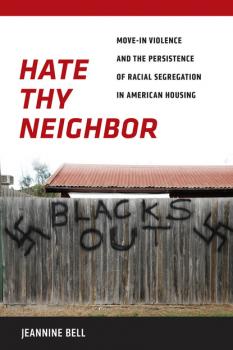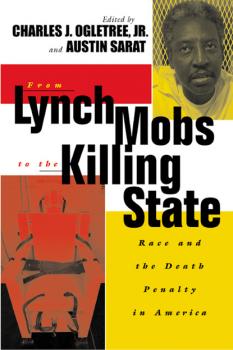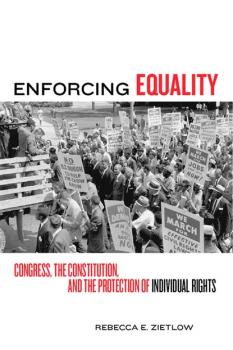ТОП просматриваемых книг сайта:
Юриспруденция, право
Различные книги в жанре Юриспруденция, право, доступные для чтения и скачиванияАннотация
2007 Ruth Shonle Cavan Young Scholar Award presented by the American Society of Criminology 2007 American Society of Criminology Michael J. Hindelang Award for the Most Outstanding Contribution to Research in Criminology By comparing how adolescents are prosecuted and punished in juvenile and criminal (adult) courts, Aaron Kupchik finds that prosecuting adolescents in criminal court does not fit with our cultural understandings of youthfulness. As a result, adolescents who are transferred to criminal courts are still judged as juveniles. Ultimately, Kupchik makes a compelling argument for the suitability of juvenile courts in treating adolescents. Judging Juveniles suggests that justice would be better served if adolescents were handled by the system designed to address their special needs.
Аннотация
The number of people incarcerated in the U.S. now exceeds 2.3 million, due in part to the increasing criminalization of drug use: over 25% of people incarcerated in jails and prisons are there for drug offenses. Judging Addicts examines this increased criminalization of drugs and the medicalization of addiction in the U.S. by focusing on drug courts, where defendants are sent to drug treatment instead of prison. Rebecca Tiger explores how advocates of these courts make their case for what they call “enlightened coercion,” detailing how they use medical theories of addiction to justify increased criminal justice oversight of defendants who, through this process, are defined as both “sick” and “bad.” Tiger shows how these courts fuse punitive and therapeutic approaches to drug use in the name of a “progressive” and “enlightened” approach to addiction. She critiques the medicalization of drug users, showing how the disease designation can complement, rather than contradict, punitive approaches, demonstrating that these courts are neither unprecedented nor unique, and that they contain great potential to expand punitive control over drug users. Tiger argues that the medicalization of addiction has done little to stem the punishment of drug users because of a key conceptual overlap in the medical and punitive approaches—that habitual drug use is a problem that needs to be fixed through sobriety. Judging Addicts presses policymakers to implement humane responses to persistent substance use that remove its control entirely from the criminal justice system and ultimately explores the nature of crime and punishment in the U.S. today.
Информация о книге
Автор произведения Rebecca Tiger
Жанр Юриспруденция, право
Серия Alternative Criminology
Аннотация
The original essays in this much-needed collection broadly assess the contemporary patterns of crime as related to immigration, race, and ethnicity. Immigration and Crime covers both a variety of immigrant groups–mainly from Asia, the Caribbean, and Latin America–and a variety of topics including: victimization, racial conflict, juvenile delinquency, exposure to violence, homicide, drugs, gangs, and border violence.The volume provides important insights about past understandings of immigration and crime, many based on theories that have proven to be untrue or racially biased, as well as offering new scholarship on salient topics. Overall, the contributors argue that fears of immigrant crime are largely unfounded, as immigrants are themselves often more likely to be the victims of discrimination, stigmatization, and crime rather than the perpetrators. Contributors: Avraham Astor, Carl L. Bankston III, Robert J. Bursik, Jr., Roberto G. Gonzales, Sang Hea Kil, Golnaz Komaie, Jennifer Lee, Matthew T. Lee, Ramiro Martínez, Jr., Cecilia Menjívar, Jeffrey D. Morenoff, Charlie V. Morgan, Amie L. Nielsen, Rubén G. Rumbaut, Rosaura Tafoya-Estrada, Abel Valenzuela, Jr., Min Zhou.
Аннотация
Despite increasingracial tolerance and national diversity, neighborhood segregation remains avery real problem in cities across America. Scholars, government officials, andthe general public have long attempted to understand why segregation persistsdespite efforts to combat it, traditionally focusing on the issue of “whiteflight,” or the idea that white residents will move to other areas if theirneighborhood becomes integrated. In HateThy Neighbor, Jeannine Bell expands upon these understandings byinvestigating a little-examined but surprisingly prevalent problem of “move-inviolence:” the anti-integration violence directed by white residents atminorities who move into their neighborhoods. Apprehensive about their newneighbors and worried about declining property values, these residents resortto extra-legal violence and intimidation tactics, often using vandalism andverbal harassment to combat what they view as a violation of their territory. Hate Thy Neighbor is the first work to seriously examine therole violence plays in maintaining housing segregation, illustrating howintimidation and fear are employed to force minorities back into separateneighborhoods and prevent meaningful integration. Drawing on evidence thatincludes in-depth interviews with ordinary citizens and analysis of FairHousing Act cases, Bell provides a moving examination of how neighborhoodracial violence is enabled today and how it harms not only the victims, butentire communities. By finally sheddinglight on this disturbing phenomenon, HateThy Neighbor not only enhances our understanding of how prevalentsegregation and this type of hate-crime remain, but also offers insightfulanalysis of a complex mix of remedies that can work to address this difficultproblem.
From Lynch Mobs to the Killing State - Austin Sarat
The Charles Hamilton Houston Institute Series on Race and JusticeАннотация
Since 1976, over forty percent of prisoners executed in American jails have been African American or Hispanic. This trend shows little evidence of diminishing, and follows a larger pattern of the violent criminalization of African American populations that has marked the country's history of punishment.In a bold attempt to tackle the looming question of how and why the connection between race and the death penalty has been so strong throughout American history, Ogletree and Sarat headline an interdisciplinary cast of experts in reflecting on this disturbing issue. Insightful original essays approach the topic from legal, historical, cultural, and social science perspectives to show the ways that the death penalty is racialized, the places in the death penalty process where race makes a difference, and the ways that meanings of race in the United States are constructed in and through our practices of capital punishment. From Lynch Mobs to the Killing State not only uncovers the ways that race influences capital punishment, but also attempts to situate the linkage between race and the death penalty in the history of this country, in particular the history of lynching. In its probing examination of how and why the connection between race and the death penalty has been so strong throughout American history, this book forces us to consider how the death penalty gives meaning to race as well as why the racialization of the death penalty is uniquely American.
Информация о книге
Автор произведения Austin Sarat
Жанр Юриспруденция, право
Серия The Charles Hamilton Houston Institute Series on Race and Justice
Federalism and Subsidiarity - Группа авторов
NOMOS - American Society for Political and Legal PhilosophyАннотация
In Federalism and Subsidiarity, a distinguished interdisciplinary group of scholars in political science, law, and philosophy address the application and interaction of the concept of federalism within law and government. What are the best justifications for and conceptions of federalism? What are the most useful criteria for deciding what powers should be allocated to national governments and what powers reserved to state or provincial governments? What are the implications of the principle of subsidiarity for such questions? What should be the constitutional standing of cities in federations? Do we need to “remap” federalism to reckon with the emergence of translocal and transnational organizations with porous boundaries that are not reflected in traditional jurisdictional conceptions? Examining these questions and more, this latest installation in the NOMOS series sheds new light on the allocation of power within federations.
Информация о книге
Автор произведения Группа авторов
Жанр Юриспруденция, право
Серия NOMOS - American Society for Political and Legal Philosophy
Аннотация
In Enforcing Equality , Rebecca E. Zietlow assesses Congress's historical role in interpreting the Constitution and protecting the individual rights of citizens, provocatively challenging conventional wisdom that courts, not legislatures, are best suited for this role.Specifically focusing on what she calls “rights of belonging”—a set of positive entitlements that are necessary to ensure inclusion, participation, and equal membership in diverse communities—Zietlow examines three historical eras: Reconstruction, the New Deal era, and Civil Rights era of the 1960s. She reveals that in these key periods when rights of belonging were contested and defined, Congress has played the role of protector of rights at least as often as the Supreme Court has adopted this role. Enforcing Equality also engages in a sophisticated theoretical analysis of Congress as a protector of rights, comparing the institutional strengths and weaknesses of Congress and the courts as protectors of the rights of belonging.With the recent new appointments to the Supreme Court and Congressional elections in November 2006, this timely book argues that individual rights are best enforced by the political process because they express the values of our national community, and as such, litigation is no substitute for collective political action.
Аннотация
Much as we “select” computer settings by default—reflexively, without thinking, and sometimes without realizing there are other options—we often discriminate by default as well. And just as default computer settings tend to become locked in or entrenched as the standard, discrimination by default creates a situation in which disparate outcomes are expected, accepted, and taken for granted. The killing of Amadou Diallo, racial disparities in medical care, the dominance of Whites and men in certain professions, and even the uneven media attention paid to crimes depending on their victims’ race and class, all might be cases of discrimination by, or as, default.Wang contends that, today, most discrimination occurs by default and not design, making legal prohibitions that focus on those who discriminate out of ill will inadequate to redress the largest share of modern discrimination. She draws on social psychology to detail three ways in which unconscious assumptions can lead to discrimination, showing how they play out in a range of everyday settings. Wang then demonstrates how these dynamics interact in medical care to produce an invisible, self-fulfilling, and self-perpetuating prophecy of racial disparity. She goes on to suggest ways in which institutions and individuals might recognize, interrupt, and override the discriminatory default.
Аннотация
As a nation ofimmigrants, the United States has long accepted that citizens who identify withan ancestral homeland may hold dual loyalties; yet Americans have at timesregarded the persistence of foreign ties with suspicion, seeing them as a sign ofpotential disloyalty and a threat to national security. Diaspora Lobbies and the US Government bringstogether a group of distinguished scholars of international politics andinternational migration to examine this contradiction in the realm of Americanpolicy making, ultimately concluding that the relationship between diasporagroups and the government can greatly affect foreign policy. This relationshipis not unidirectional—as much as immigrants make an effort to shape foreignpolicy, government legislators and administrators also seek to enlist them infurthering American interests. From Israel to Cuba and from Ireland to Iraq, the casestudies in this volume illustrate how potential or ongoing conflicts raise thestakes for successful policy outcomes. Contributors provide historical andsociological context, gauging the influence of diasporas based on populationsize and length of time settled in the United States, geographic concentration,access to resources from their own members or through other groups, and thenature of their involvement back in their homelands. This collection brings a freshperspective to a rarely discussed aspect of the design of US foreign policy andoffers multiple insights into dynamics that may determine how the United Stateswill engage other nations in future decades.
Аннотация
For close to a century, the field of community criminology has examined the causes and consequences of community crime and delinquency rates. Nevertheless, there is still a lot we do not know about the dynamics behind these connections. In this book, Ralph Taylor argues that obstacles to deepening our understanding of community/crime links arise in part because most scholars have overlooked four fundamental concerns: how conceptual frames depend on the geographic units and/or temporal units used; how to establish the meaning of theoretically central ecological empirical indicators; and how to think about the causes and consequences of non-random selection dynamics. The volume organizes these four conceptual challenges using a common meta-analytic framework. The framework pinpoints critical features of and gaps in current theories about communities and crime, connects these concerns to current debates in both criminology and the philosophy of social science, and sketches the types of theory testing needed in the future if we are to grow our understanding of the causes and consequences of community crime rates. Taylor explains that a common meta-theoretical frame provides a grammar for thinking critically about current theories and simultaneously allows presenting these four topics and their connections in a unified manner. The volume provides an orientation to current and past scholarship in this area by describing three distinct but related community crime sequences involving delinquents, adult offenders, and victims. These sequences highlight community justice dynamics thereby raising questions about frequently used crime indicators in this area of research. A groundbreaking work melding past scholarly practices in criminology with the field’s current needs, Community Criminology is an essential work for criminologists.










